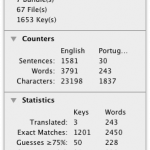Just today, I have finished a great series of nice new features around dictionaries in the Localization Manager. So here it goes:
- First, of course, you can open and load dictionaries and files like it’s in Localizer. This is needed for the following features.
- Trivially, this enables support for automatic translation. While the best place to do this is still the Localizer, you are now able to automatically translate files in the Manager as well. This may come in quite handy when you split up a interface file and want to transfer the strings from one to the other.
- Next up are embedded dictionaries. Having loaded dictionaries in the manager enables the ability to include tailored — embedded — dictionaries in exported Localizer files. This reduces the need to ship dictionaries separately and comes in handy especially when the developer wants to ensure consistency. So embedding the system glossaries and the one of your old version will ensure maximum consistency. Additionally, these embedded dictionary will contain keys that match only. This has two benefits: first the dictionary will be smaller and thus the file, and second, you do not transfer your complete knowledge base. The translator could “steal” (i.e. copy it and keep it as his own) the dictionary, so you will want to keep it as small as possible.
- One thing else that can be done when having dictionaries, is calculating statistics. I am very proud to present the (like version 2.0) updated statistics panel:

Not only that the sections are collapsible and nicely animated (yay), the major new thing is the third part. As you can see, there are detailed statistics about the selected keys in relation to your knowledge base. This is especially interesting for professional translators to estimate their work and calculate the price for a translation. Counts are being given in key pairs and words.
That’s the main thing. I also fixed several bugs (see commit log for details) and added export and import facilities to the Localizer. This enables Localizers to save their work done to a dictionary in order to not loose any data. And this allows agencies to work on Localizer files, but to export the actual translation work to XLIFF and reimport it later. Flexibility as it ought to be (at least in my opinion)!
I’d love to get some feedback.
BTW: These things are online right now. Have a look in the nightly trunk.
